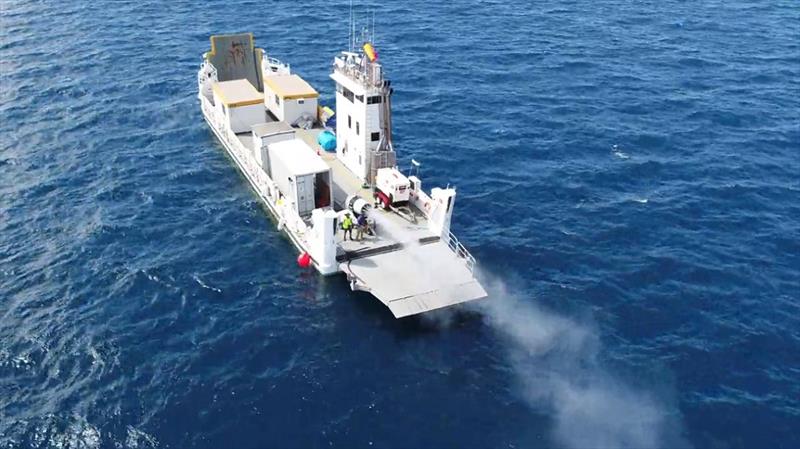
Scientists trial world-first 'cloud brightening' technique to protect corals
by Jessica Nelson 18 Apr 2020 08:59 UTC

Cloud brightening equipment © Brendan Kelaher Southern Cross University
As the world grapples with COVID-19, the Great Barrier Reef is facing a crisis of its own - its third mass bleaching in five years.
Days before virus restrictions were imposed, a research team led by the Sydney Institute of Marine Science and Southern Cross University successfully trialled world-first 'cloud brightening' technology off the Townsville coast to protect our valuable reef systems from future bleaching events.
Project leader and Southern Cross University Senior Lecturer Dr Daniel Harrison said cloud brightening was one of the most innovative and promising potential methods that could protect very large areas of reef.
"Cloud brightening could potentially protect the entire Great Barrier Reef from coral bleaching in a relatively cost-effective way, buying precious time for longer-term climate change mitigation to lower the stress on this irreplaceable ecosystem," Dr Harrison said.
"Microscopic sea water droplets are sprayed into the air, evaporating leaving just nano-sized sea salt crystals which act as seeds for cloud droplets, brightening existing cloud and deflecting solar energy away from the reef waters when heat stress is at its maximum.
"In the future this technology might be able to be applied over the Great Barrier Reef to reduce the severity of coral bleaching during marine heat waves, cooling and shading the corals below."
Researchers from Southern Cross University's National Marine Science Centre in Coffs Harbour teamed up with the Sydney Institute of Marine Science (SIMS), the University of Sydney and Queensland University of Technology (QUT) to test prototype equipment developed in partnership with EmiControls of Italy. Future trials will be funded through the Federal Government's $150m RRAP Research and Development phase announced on Thursday.
"The Great Barrier Reef is undergoing a third mass bleaching event in just five years, and corals were bleaching all around us while we conducted our tests. This was both shocking and heartbreaking, in what should have been an ordinary non-El Nino non-bleaching year. It really emphasises how little time we have for this research, reminding us of how important this work is."
Traditional Owner of Manduburra, Mr Usop Drahm, who joined the expedition said: "we welcome scientific research where indigenous people and the rest of Australia work together to maintain the reef ecosystem for future generations. This technology might help prevent bleaching and we like that it uses no chemicals and relies on natural processes."
With only a skeleton crew on board and without any of the international researchers who had planned to join, the team set up on two large vessels near Broadhurst Reef, 100km off the coast of Townsville in Far North Queensland. The prototype cloud brightening machine along with its ancillary equipment and accommodation for the scientists was on an ocean barge. A smaller second vessel was fitted out with air sampling equipment that normally never leaves the lab. Instruments weighing over 80kgs had to be loaded by crane through the vessel roof.
"We tested the hypothesis at one-tenth of the scale we're aiming for, using a drone in the atmosphere and a sampling vessel 5km away on the sea surface and showed how we can successfully create hundreds of trillion of these sea salt crystals per second which float up into the atmosphere to bolster the reflectivity of the existing clouds," Dr Harrison said.
Every cloud droplet needs a nucleus to condense onto, and Dr Harrison's previous research as a 2017 Myer Innovation Fellow led him to believe that there may be a shortage of suitable nuclei during summertime conditions when coral bleaching occurs.
"Nobody has previously measured atmospheric particle concentrations above the reef before and during bleaching conditions," he said. "We were amazed to see that the numbers of natural atmospheric nuclei were far lower than even I had suspected."
Next year the team plans to test the technology at three times the size, ready for a ten-fold increase a year later, which the researchers say should be able to brighten clouds across a 20-by-20-kilometre area. Over the next four years researchers from multiple institutions will explore all aspects of the technology including considering environmental risks such as whether the technology could alter rainfall patterns over the ocean or land.
SIMS CEO Professor Peter Steinberg said the organisation was very excited in the research progress including first steps towards scaling-up the cloud brightening technology.
"The ability to deploy such innovative solutions at scale is a crucial part of an overall approach to the mitigating the impacts of our warming oceans," he said.
In order to safely carry out the fieldwork as the COVID crisis began to unfold, Dr Harrison and the core team drove 3,600km north to Townsville from Coffs Harbour, and back, camping and preparing their own food along the way to remain isolated from others not involved in the project.
This project was funded through the Queensland and Australian Governments' Boosting Coral Abundance Challenge, led by Sydney Institute of Marine Science, co-led by Southern Cross University in partnership with Queensland University of Technology, the University of Sydney, Australian Institute of Marine Science, EmiControls, Ron Allum Deepsea Engineering, Riverside Marina, and Blue Planet Marine.
Yesterday the Federal Government launched the $150m research and development phase of the world-leading Reef Restoration and Adaptation science Program (RRAP) to help preserve and restore the Great Barrier Reef, which includes larger trials of Dr Harrison's Cloud Brightening technique.